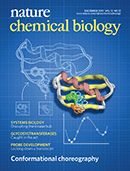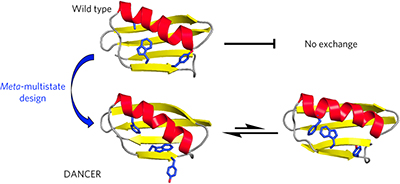Advertisement |
 |
| |
 |
 |
TABLE OF CONTENTS
|
December 2017 Volume 13, Issue 12 |
 |  |  |
 |  Research Highlights Research Highlights
 News and Views News and Views
 Articles Articles
 Errata Errata
| |
 |
|
 |
 |
| Advertisement |
 |
Nature Collection: 2017
Nobel Prize in Physiology or Medicine The 2017 Nobel Prize in Physiology or Medicine was awarded to Jeffrey C. Hall, Michael Rosbash and Michael W. Young for their pioneering work in Drosophila that elucidated the molecular mechanisms controlling circadian rhythm.
Access this collection free online | | |
 |
| |
Research Highlights |  Top Top |
 |
 |
 |
Nucleic acids: mRNAs get a TREAT | Peptide design: Hacking hemagglutinin | Host-pathogen interactions: A ubiquitin defense | Enzymology: I want my cluster back
|
News and Views |  Top Top |
 |
 |
 |
| |
 |
| Advertisement |
 |
| Do you have a career question? The Naturejobs podcast features one-on-one Q&As, panel discussions and other exclusive content to help scientists with their careers. Hosted on the Naturejobs blog, the podcast is also available on iTunes and Soundcloud. Listen today! |  | | |
 |
| |
Articles |  Top Top |
 |
 |
 |
|
 |
 |
 |
|
 |
 |
 |
|
 |
 |
 |
The structure-energy landscape of NMDA receptor gating pp1232 - 1238
Drew M Dolino, Sudeshna Chatterjee, David M MacLean, Charlotte Flatebo, Logan D C Bishop et al.
doi:10.1038/nchembio.2487

A linear gating mechanism links kinetically and structurally distinct closed and open states of NMDA receptors. During allosteric inhibition, agonist binding incudes uncoupling of structural changes from gating motions in the first transmembrane region.
|
|
|
 |
 |
 |
|
 |
 |
 |
|
 |
 |
 |
|
 |
 |
 |
|
 |
 |
 |
|
 |
 |
 |
|
 |
 |
 |
Rational design of proteins that exchange on functional timescales pp1280 - 1285
James A Davey, Adam M Damry, Natalie K Goto and Roberto A Chica
doi:10.1038/nchembio.2503

The development of a computational protein design method, meta-multistate design, enables the design and validation of protein variants termed DANCERs that spontaneously exchange between predicted conformational states on the millisecond timescale.
|
|
|
 |
Errata |  Top Top |
 |
 |
 |
Errata: Functional annotation of chemical libraries across diverse biological processes p1286
Jeff S Piotrowski, Sheena C Li, Raamesh Deshpande, Scott W Simpkins, Justin Nelson et al.
doi:10.1038/nchembio1217-1286a
|
 |
 |
 |
Errata: Functional annotation of chemical libraries across diverse biological processes p1286
Jeff S Piotrowski, Sheena C Li, Raamesh Deshpande, Scott W Simpkins, Justin Nelson et al.
doi:10.1038/nchembio1217-1286b
|
 |
 Top Top |
 |
 |
| Advertisement |
 |
| |
 |
| |
 |  |  |  |  |  | Natureevents is a fully searchable, multi-disciplinary database designed to maximise exposure for events organisers. The contents of the Natureevents Directory are now live. The digital version is available here.
Find the latest scientific conferences, courses, meetings and symposia on natureevents.com. For event advertising opportunities across the Nature Publishing Group portfolio please contact natureevents@nature.com |  |  |  |  |  |
|
 |


1 comment:
Many studies require the use of peptides with more than 50 to 150 amino acids. Researches have also shown that synthetic long peptide-binding adjuvants have been widely used in cancer therapeutic vaccine research. Long Peptides Synthesis
Post a Comment